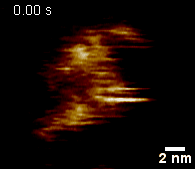- Structural Dynamics of Single Molecules
- AFM Software
- Localization AFM
- High-Speed AFM Height Spectroscopy
- Dynamics of Lipid Membranes
Structural Dynamics of Single Molecules
The rapid expansion in the structural understanding of proteins through recent progress in electron microscopy and X-ray crystallography is leading to an ever-greater need for techniques which give high temporal resolution dynamics. High-Speed Atomic Force Microscopy (HS-AFM) provides unprecedented real-space and real-time visualisation of biological molecules (<1 nm lateral, ~0.1 nm vertical and >100 ms temporal resolution). Our research interests are focused on developing techniques to study the structure and dynamics of biomolecules at previously inaccessible time and spatial resolutions using atomic force microscopy. In doing this we aim use physics and physical tools to better understand biological processes related to health and disease.

AFM Software
We develop open-source software for the analysis of AFM data with the aim of improving analysis, throughput and access to data. Visit our software page for details of available software.
NanoLocz: Image Analysis Platform for AFM, High-Speed AFM, and Localization AFM
Heath GR, Micklethwaite E, Storer TM
Small Methods, (2024) 2301766.
Localization AFM
Localization AFM (LAFM) is a technique developed to overcome current resolution limitations in AFM. By applying localization image reconstruction algorithms to peak positions in high-speed AFM and conventional AFM data, we increase the resolution beyond the limits set by the tip radius, and resolve single amino acid residues on soft protein surfaces in native and dynamic conditions. LAFM enables the calculation of high-resolution maps from either images of many molecules or many images of a single molecule acquired over time, facilitating single-molecule structural analysis. LAFM is a post-acquisition image reconstruction method that can be applied to any biomolecular AFM dataset.

Localization Atomic Force Microscopy
Heath GR, Kots E, Robertson JL, Lansky S, G Khelashvili, Weinstein H & Scheuring S.
Nature, 594, 7863 (2021).
High-Speed AFM Height Spectroscopy
We have recently developed HS-AFM to increase the already pioneering 100ms time resolution to 10μs. This 10,000-fold leap in acquisition rate is achieved by no longer scanning the surface with a tip, but by holding it at a single point of interest and studying the dynamics of molecules underneath. This offers the capability to directly study how protein dynamics can be modulated by various small molecules and stimuli to inform the pursuit of therapeutics.
High-Speed AFM Height Spectroscopy (HS-AFM-HS): μs dynamics of unlabeled biomolecules
Heath GR & Scheuring S. Nature Communications, 9, 1, (2018)
